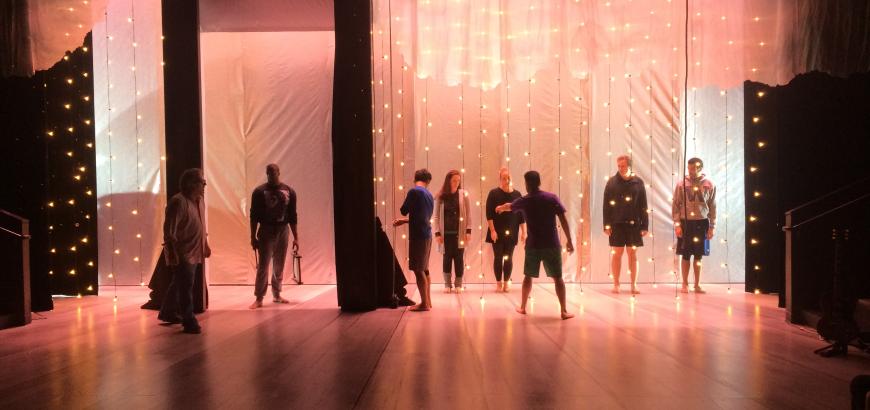Below, Whit reflects on his time in residence at UW School of Drama, the joys and challenges of making performance work from scratch, and the process of building 'Cold Empty Terrible.'
1) How does creating performance through a group-generated process benefit the PATPs as artists?
These group-created pieces put actors closer to the driver’s seat of the generative process. By building a work for the stage from scratch, actors get to partake of an excitement that is really one of a kind. And they get the news, first hand, that a play is not a thing per se, it’s a road map, a series of thoughts and actions that lead to an outcome. That’s easy to forget in the day-in-day-out RE-creative process of conventional theatre practice.
As we practice it, devising also helps make connections between some of their various trainings. Our movement style helps actors connect the dots.
2) How do you and your collaborators create content from scratch? Where do you start?
We start a number of ways in New Paradise Laboratories, but usually one feature of our practice involves visual art. We often choose paintings as starting points, because of the worlds they describe and depict. We identify artists, put a number of canvases up on their feet, set them into motion, and see what happens. We collage the results – looking for accidental connections between seemingly unrelated thoughts, and run from there.
I have an idea and I watch what comes up with that in mind. It’s amazing to me, still, that some sort of thought process and story starts to come into view from looking at a wide variety of very disparate material. We talk – a lot – and start to understand what we’re making.
3) What are some of the challenges of building theatre from the ground up?
Anxiety can run rampant. Devising makes us all contemplate over and over that not-knowing is an important practice. One must practice uncertainty as a precursor to knowing. This brings me to a second challenge: creating from scratch takes time. You have to have time to move from not-knowing to coherence; which means that it’s a practice that requires extra resources of time and money.
Devising makes us all contemplate over and over that not-knowing is an important practice. One must practice uncertainty as a precursor to knowing.
4) What prompted your decision to focus on Treplev's infamous, aborted play from The Seagull as inspiration for Cold Empty Terrible?
I’m a contrarian, to a certain degree, and I find Treplev’s suicide to be so wasteful, so I’m led to want to counteract the forces leading to it. I wanted to give his play a production that he might like. Most productions of The Seagull start with the forgone conclusion that Treplev’s play is as ridiculous as his mother describes it. I think it’s actually pretty awesome. Making something of it is a quixotic venture, to be sure, but I also think it’s a work with a proto-avant garde sensibility. Almost all great things start out as experiments.
5) You utilized some of the same source material to create The Adults, your company's most recent production in Philadelphia. What is the relationship of these two pieces? How are the themes of these works in conversation with each other?
Mostly, I listened to the UW students talk, and their concerns seemed to jive with some of Chekhov’s concerns in his play. It tickled me to imagine two productions – one, The Adults – researching the values of Chekhovianism, and the other – Cold Empty Terrible – the values of “Treplevianism”.
6) How do you prompt designers to create concepts for material that hasn't been built yet?
It’s a weird process. But in some ways it’s akin to what the actors go through. I say, here are some ideas we are playing with. What would be a pedestal for these ideas? Not just a stand for a sculpture, but the most awesome frame you can imagine for a painting that’s just coming into being. For Cold Empty Terrible, Julia Welch, the scenic designer, put forth probably 20 ideas before we came across the one that I thought might work.
And what does a costume designer do? I gave Maya Ogawasara about 5 directives and we just chose. In that case, she had a great deal of influence over the outcome of the piece. We chose three basic notions: a Chekhovian world, swim wear, and creatures from an unknowable future. In doing so, she helped conceive of the piece and “write” it.
7) How have you been influenced by your experience working with the PATPs on Cold Empty Terrible?
I’ve been thinking a lot about what helps actors take the reins of their own careers. Traditionally, they have to accommodate many other peoples’ wishes and demands. How do they identify their own concerns? And work from them, building a career that has meaning and substance. The same sort of heft that I get as a producer/writer/director.
Cold Empty Terrible previews October 15 & 16 and runs October 17 - 26. Performances are Wednesday-Saturday at 7:30pm and Sundays at 2pm in the Floyd and Delores Jones Playhouse, located at 4045 University Way NE.



